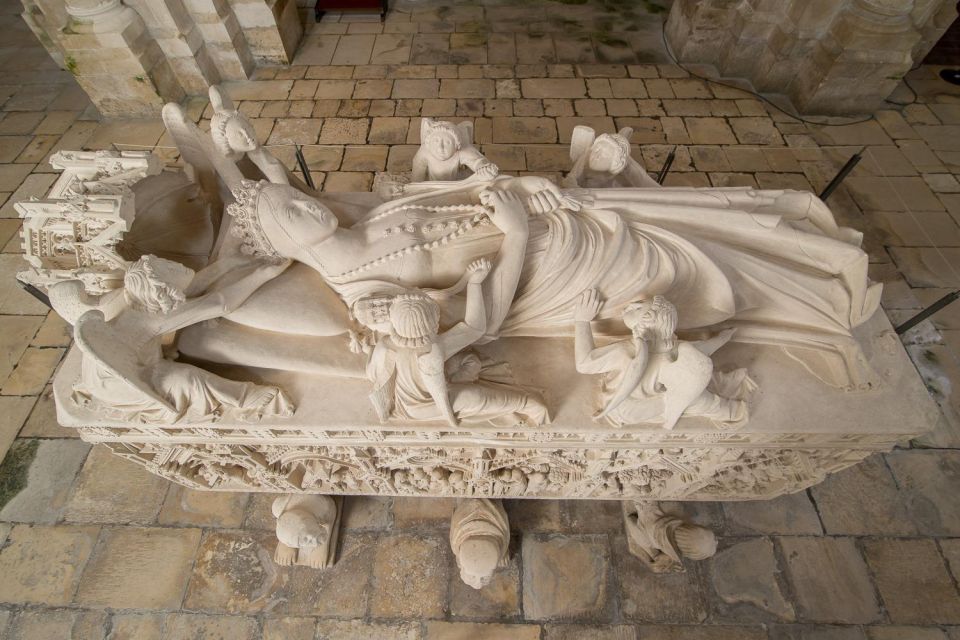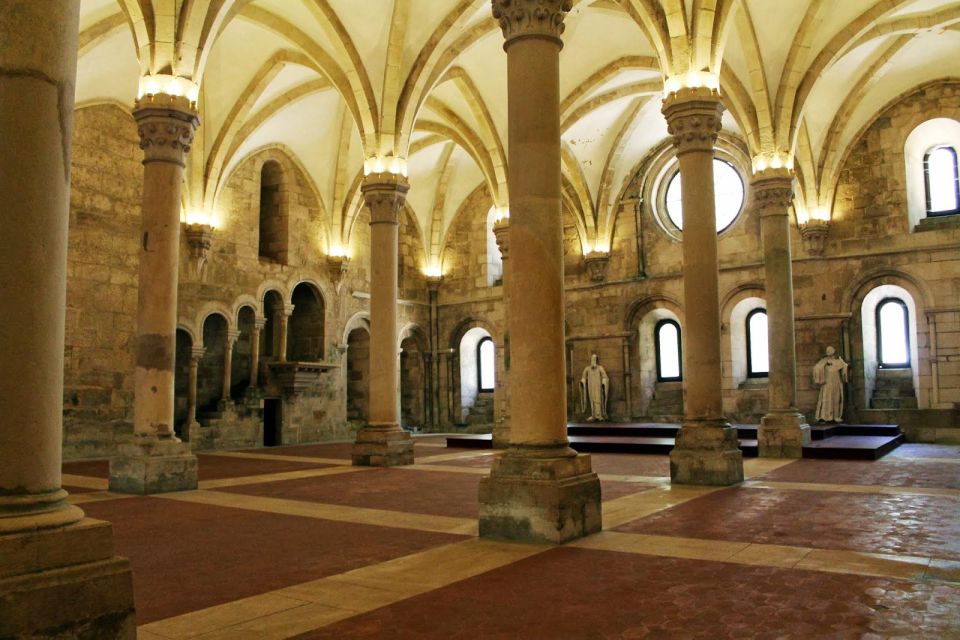Alcobaça Monastery: Guided Tour
As visitors step through the grand entrance of Alcobaça Monastery, they are met with a palpable sense of history that permeates every stone and archway. The intricate details of the architecture whisper tales of a bygone era, where love and tragedy intertwined in the shadow of its walls.
But beyond the surface lies a labyrinth of corridors and chambers, each holding secrets waiting to be unveiled. Join this guided tour to uncover the hidden stories of devotion, power, and passion that have shaped the very essence of this revered Portuguese landmark.
Key Points

- Explore the legendary love story of Pedro and Inês.
- Experience the daily life and traditions of Cistercian monks.
- Discover the profound historical and cultural significance of Alcobaça Monastery.
- Indulge in local delicacies like pastry and Ginjinha while immersing in Portugal’s rich heritage.
Monastery’s Historical Significance

Founded by the first Portuguese King, the Alcobaça Monastery stands as a testament to architectural marvels and religious practices. This grand edifice not only showcases royal connections but also upholds Cistercian traditions, making it the largest center of its kind in Europe. Monks at Alcobaça followed the motto ‘Pray and Work,’ contributing to the monastery’s rich history and significance.
The tragic love story of Pedro and Inês, immortalized within its walls, highlights the pursuit of justice that ensued. As Pedro ascended to the throne, Inês was posthumously crowned Queen, symbolizing their eternal bond. The assassins of Inês met their fate, solidifying the legend of their hearts being taken out.
The Alcobaça Monastery remains a beacon of historical and cultural heritage, attracting visitors worldwide.
Pedro and Inês Love Story

The tragic love story of Pedro and Inês, immortalized within the walls of Alcobaça Monastery, encapsulates a tale of romance, power, and enduring devotion that captivates visitors to this day.
Pedro, the Crown Prince of Portugal, fell deeply in love with Inês de Castro, a lady-in-waiting to his wife. Their forbidden love sparked jealousy and fear, leading to Inês’ tragic assassination.
Despite the turmoil, their love endured, symbolizing eternal romance amidst tragedy. Pedro later became King and sought justice for Inês by executing her murderers.
The story goes that their hearts were buried together, a poignant symbol of their unending love. This tale of tragic love continues to fascinate and resonate within the hallowed halls of the Alcobaça Monastery.
Daily Life of Cistercian Monks

Amidst the serene cloisters of Alcobaça Monastery, Cistercian monks engage in a daily rhythm of prayer, work, and contemplation that defines their devoted way of life. Their monastic routines are meticulously structured, starting before dawn with the first prayers of the day.
Following this, the monks dedicate themselves to various tasks, including tending to the monastery’s gardens, crafting artisanal goods, and maintaining the sacred spaces. Culinary traditions hold a special place in their daily lives, with the monks known for their legacy of exquisite pastries and the production of Ginjinha, a traditional Portuguese liqueur.
Through their disciplined routine and commitment to prayerful contemplation, the Cistercian monks at Alcobaça Monastery embody a timeless devotion to their faith and community.
Alcobaça Monastery’s Legacy
In the hallowed halls of Alcobaça Monastery, the enduring legacy of the Cistercian monks resonates through centuries of cultural and historical significance. The monks’ influence extends beyond prayer and work, leaving a lasting impact on culinary traditions and artistic endeavors.
Through their profane legacy, they’ve enriched Portugal’s cultural heritage with delectable pastries and the famous Ginjinha liqueur. On top of that, the artistic influence of the monks can be seen in the monastery’s architecture and intricate carvings, showcasing their dedication to craftsmanship and creativity.
Alcobaça Monastery stands as a testament to the monks’ commitment to preserving rich history and traditions, making it a must-visit destination for those seeking to enjoy Portugal’s past.
Cultural Impact on Portugal

With a profound cultural influence, Portugal has been shaped by the traditions and heritage preserved at Alcobaça Monastery. The monastery’s Cistercian influence and dedication to the motto "Pray and Work" have left an indelible mark on Portuguese traditions. Here is a table highlighting the cultural impact on Portugal:
| Cultural Impact | Description |
|---|---|
| Portuguese traditions | Alcobaça Monastery has contributed to the preservation and celebration of Portuguese customs and practices. |
| Cistercian influence | The Cistercian monks’ presence at the monastery has influenced the development of Portugal’s cultural heritage. |
The blend of Cistercian practices and Portuguese traditions at Alcobaça Monastery continues to resonate throughout the region, making it a significant cultural landmark in Portugal.
Exploring Monastery and Grounds
Visitors to Alcobaça Monastery are greeted with a grand architectural marvel, steeped in centuries of history and cultural significance. The monastery’s intricate design and towering walls showcase the mastery of Gothic architecture, inviting exploration of its hidden gems.
As visitors wander through the monastery and grounds, they’re surrounded by a serene atmosphere, making it a perfect spiritual retreat. The scenic beauty of the surrounding landscape adds to the tranquil ambiance, providing a peaceful setting for reflection and contemplation.
The monastery’s courtyards, chapels, and cloisters offer a glimpse into the past, allowing visitors to enjoy the history and architecture of this remarkable site. Alcobaça Monastery truly captivates with its architectural wonders and serene surroundings.
Immersive Experience and Local Delights
Upon entering the vibrant streets surrounding Alcobaça Monastery, one is immediately enveloped in a sensory journey that merges the region’s rich history with its delectable local delights. Visitors can indulge in:
-
Local Cuisine: Sample traditional Portuguese dishes like Bacalhau à Brás or Pastéis de Nata at quaint eateries nestled near the monastery.
-
Architectural Marvels: Marvel at the intricate Manueline architecture of the monastery, a UNESCO World Heritage site that showcases stunning Gothic and Baroque elements.
-
Culinary Delights: Savor a glass of Ginjinha, a cherry liqueur enjoyed by locals, while strolling through the picturesque streets of Alcobaça, immersing oneself in the cultural tapestry of the region.
Common questions
How Did the Monks at Alcobaça Monastery Preserve Their Pastry-Making Tradition Over the Centuries?
Monks at Alcobaça Monastery preserved their pastry-making tradition through meticulous documentation of pastry techniques, passing down recipes through generations, and integrating local ingredients. Culinary traditions were safeguarded, ensuring the historical significance of their creations endured.
What Specific Work Duties Did the Cistercian Monks at Alcobaça Monastery Partake in on a Daily Basis?
The Cistercian monks at Alcobaça Monastery partook in a range of daily work duties, including prayer, manual labor, manuscript copying, farming, and tending to the monastery’s needs. These activities were integral to their daily rituals and spiritual practices.
How Has the Story of Pedro and Inês Influenced Portuguese Literature and Art Throughout History?
The story of Pedro and Inês has profoundly shaped Portuguese literature and art, influencing historical narratives, cultural practices, and immersive experiences. Its enduring impact reflects the deep-rooted connection between tradition, love, and artistic expression.
What Are Some Lesser-Known Cultural Traditions That Are Still Practiced at Alcobaça Monastery Today?
Visitors can explore modern practices at Alcobaça Monastery, showcasing its rich cultural heritage. Daily routines of prayer and work continue, while lesser-known artistic influences are evident in the monastery’s architecture and decorative elements, adding depth to its historical significance.
Can Visitors Participate in Any Immersive Experiences or Workshops to Learn More About the Daily Life of Monks at Alcobaça Monastery?
Visitors can enjoy the daily life of monks at Alcobaça Monastery through immersive experiences and workshops. These activities offer insight into the monks’ routines, prayer practices, and the rich cultural traditions preserved at the monastery.
Last Words
Discover the enchanting allure of Alcobaça Monastery on a guided tour that brings history to life. From the tragic love story of Pedro and Inês to the daily rituals of the Cistercian monks, each corner of this cultural gem tells a story of Portugal’s rich heritage.
Enjoy the monastery’s legacy, explore its hallowed halls, and savor the local delights that make this experience truly unforgettable. Alcobaça Monastery awaits, ready to captivate and inspire all who visit.